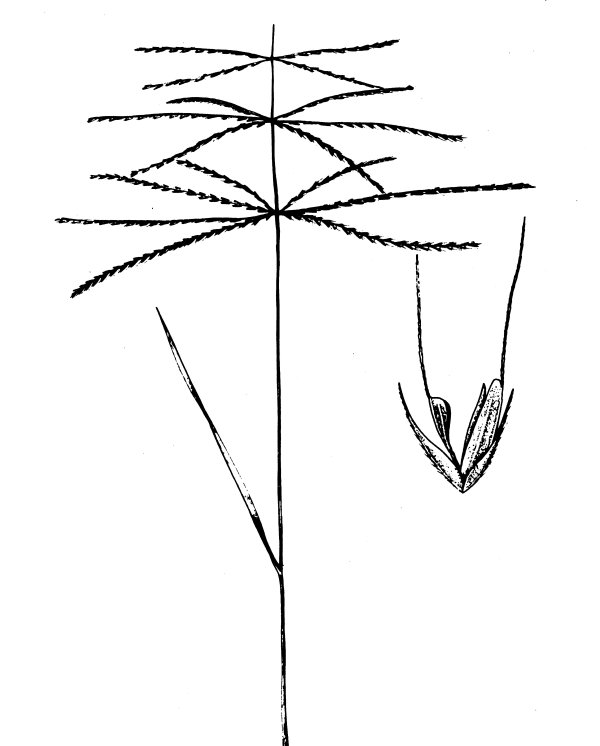
Chloris verticillata Nutt. Windmillgrass Habit: Tufted perennial. Culms: 10-40 cm. tall, erect or decumbent at the base, sometimes rooting at the lower nodes. Blades: Crowded at the base, light green 3-7 cm. long, 1-4 mm. wide, the upper shorter, folded, abruptly pointed, margin and surface scabrous. Sheaths: Shorter than the internodes, loose, flattened. Ligule: Membranous, fringed, less than 1 mm. long. Inflorescence: Spikes slender, 8-13 (21), usually widely spreading, 5-11 cm. long, in 1-3 whorls, often naked at the base, clustered ate the apex of the culm, axils usually pubescent, the slender rachis, scabrous. Inflorescence breaks away as a tumbleweed. Spikelets: Without the awns about 3 mm. long, flattened, 1 perfect flower, crowded in two rows, in verticillate or approximate spikes, the rachilla disarticulating above the glumes and prolonged behind the palea and bearing 1 or more rudimentary awned sterile lemmas. Glumes: 1-nerved, acuminate, awn-pointed, narrow, scabrous on the nerves, first about 2 mm. long, the second about as long as the spikelet. Lemmas: Exclusive of the awn, 2-3 mm. long, 3-nerved, obtuse, the nerves ciliate, especially the lateral ones, bearing just below the apex a scabrous awn, usually 2-5(8) mm. long, sterile lemma one, 1.5-2 mm. long, less than 1 mm. wide, truncate, 3-nerved, bearing below the apex an awn shorter than that of the fertile lemma. Palea: Folded, 2-keeled, about equaling the lemma. Rudiment: Cuneate-oblong, rather turgid, about 0.7 mm. wide as folded, truncate, the awn about 5 mm. long. Fruit: Grain free within the lemma and palea. Habitat: Prairies and plains. May-July; September. Kansas Range: Throughout.